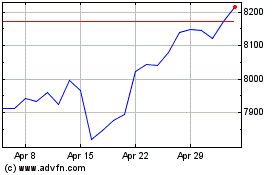By Mark DeCambre, MarketWatch
The bond market is closed for Columbus Day
U.S. stocks traded lower Monday in a choppy session as investors
wrestled with fears about rapidly rising rates against expectations
for strong corporate results in coming days.
On top of that, investors were keeping an eye on the potential
for tensions between Italy and the European Union over budgetary
concerns.
The bond market was closed in observance of Columbus Day
(http://www.marketwatch.com/story/why-monday-may-offer-a-respite-for-stock-market-investors-after-a-bruising-bond-rout-2018-10-05)
and Indigenous Peoples' Day.
How are major benchmarks faring?
The Dow Jones Industrial Average traded 183 points, or 0.7%,
lower at 26,260, while the S&P 500 index declined by about 19
points to reach 2,866, a fall of 0.7%. The Nasdaq Composite Index
retreated by 103 points, or 1.4%, at 7,683.
All three benchmarks had been swinging between gains and
losses.
Defensive stocks were drawing bids, with consumer staples, led
by Conagra Brands Inc. (CAG) and Dow component Walgreens Boots
Alliance Inc. (WBA) higher. One measure of consumer staples, the
Consumer Staples Select Sector SPDR ETF (XLP), was gaining as were
S&P 500's real estate and utilities sectors, up more than 1%
each.
The Dow slumped 0.7%
(http://www.marketwatch.com/story/us-stocks-look-poised-to-resume-yield-driven-stumble-2018-10-08)
to 26,447.05 Friday. The S&P 500 fell 0.6% to 2,885.57 and the
Nasdaq dropped 1.2% to 7,788.45.
A decline for Dow, S&P 500 and Nasdaq would represent its
third straight drop.
Monday's action comes after the Nasdaq logged its worst weekly
decline since March 23 and the S&P 500 logged its second
straight weekly decline amid a surge in long-dated Treasury rates
to their highest since 2011. Bond prices fall as yields rise.
Read: 3 reasons why U.S. government bond yields are soaring
(http://www.marketwatch.com/story/3-reasons-why-us-government-bond-yields-are-soaring-2018-10-03)
What's driving the market?
A jump in government bond yields over the past several sessions
has perhaps heralded a new phase in postcrisis markets that have
enjoyed a protracted period of ultra low yields.
Last week saw the yield on the 10-year U.S. Treasury note rise
17 basis points, representing its sharpest weekly advance since
February and taking it toward 3.23%, its highest level in about
seven years.
Higher yields equates to steeper borrowing costs for
corporations and investors alike and has caused a reassessment of
equity valuations, already deemed lofty by some measures.
On top of that, richer rates of so-called risk-free bonds can
compete against equities, which are perceived as comparatively
riskier.
Climbing rates, however, have come against a solid backdrop for
the domestic economy, with the unemployment rate falling to its
lowest level since 1969
(http://www.marketwatch.com/story/jobs-report-still-consistent-with-strong-economy-even-as-employment-gains-slow-economists-say-2018-10-05)
and a number of other gauges in previous weeks have underlined the
notion that the U.S. expansion continues apace.
Read:Sure, yields are rising--but it's the bond market's
velocity that threatens to throttle stocks
(http://www.marketwatch.com/story/sure-yields-are-risingbut-its-the-bond-markets-velocity-that-threatens-to-throttle-stocks-2018-10-07)
As for quarterly results, companies in the S&P 500 are
projected to post 10% earnings growth in 2019, according to
FactSet, offering more evidence of economic health.
Abroad, investors were also watching developments in Europe,
with the EU signaling in a letter Friday to Italy's economic
minister, Giovanni Tria, that Italy's budget targets are a source
of concern for the trading bloc
(http://www.marketwatch.com/story/european-commission-expresses-serious-concern-over-italy-budget-report-2018-10-06),
setting up a potential market-disrupting clash.
Additionally, Wall Street is following the progress in trade
talks between the U.S. and its major partners, including China,
which had previously been the main source of volatility for global
markets. A tit-for-tat tariff battle between Beijing and Washington
remains intact.
What are analysts saying?
"The yield on the 10-year hit a fresh seven year high on Friday,
and dealers are using that as a cue to exit the stock market for
fear of higher rates. The Fed have upped interest rates three times
in 2018, and traders are pricing in a high probability of a hike in
December too," wrote David Madden, market analyst at CMC Markets
UK.
"The market got off to a strong start in the final quarter of
the year, only to stumble on rising bond yields. The yield effect
and the upcoming earnings season, we think, will likely curtail
investors' appetite for stocks as the game in town is challenged by
higher rates," said Peter Cardillo, chief market economist at
financial services firm Spartan Capital Securities, in a Monday
report.
"While we think the overall earnings season will be favorable,
the weight of tariffs will be felt in some situations, which could
lead to a less enthusiastic market atmosphere. We continue to
remain optimistically cautious in the near term," he said.
Which stocks are in focus?
Shares of Tesla Inc. (TSLA) fell 3.1%, despite the electric-car
maker Sunday night saying that it has achieved its goal of making
the Model 3 sedan the safest car ever built
(http://www.marketwatch.com/story/tesla-says-its-model-3-has-lowest-probability-of-injury-of-any-car-tested-by-nhtsa-2018-10-07).
Read: Einhorn sees shades of Lehman in Tesla, says Musk knows
deception is catching up to him
(http://www.marketwatch.com/story/einhorn-sees-shades-of-lehman-in-tesla-says-musk-knows-deception-is-catching-up-to-him-2018-10-05)
ENSCO PLC's stock (ESV) was up 1.8% after Rowan Cos. PLC(RDC)
announced a merger
(http://www.marketwatch.com/story/ensco-and-rowan-cos-to-combine-in-deal-with-enterprise-value-of-12-billion-2018-10-08)
valued at $12 billion. Shares of Rowan were up 1.9%.
What other markets are in focus?
China's major indexes in Shanghai and Shenzhen closed down by
more than 3.5%, as traders returned to work after a weeklong
holiday, and as China's central bank loosened reserve requirements
(http://www.marketwatch.com/story/asian-markets-lag-as-chinese-stocks-fall-after-weeklong-layoff-2018-10-07).
Crude-oil prices were trading firmly lower, while gold was under
pressure and the U.S. dollar index gained 0.4%, proving to be
headwinds for assets priced in the currency.
(END) Dow Jones Newswires
October 08, 2018 12:22 ET (16:22 GMT)
Copyright (c) 2018 Dow Jones & Company, Inc.
FTSE 100
Index Chart
From Mar 2024 to Apr 2024

FTSE 100
Index Chart
From Apr 2023 to Apr 2024
